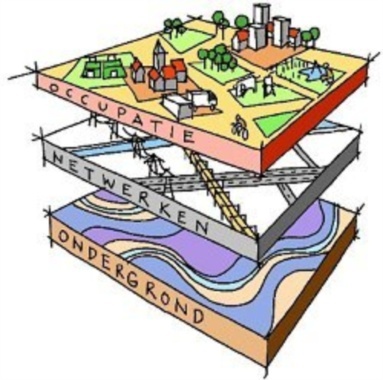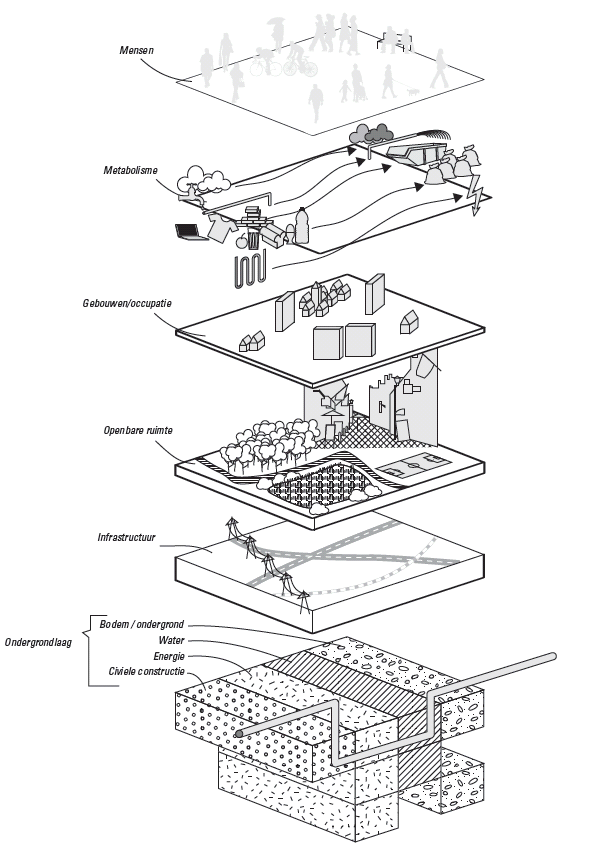...
BackgroundUntil the Industrial revolution we were forced to adapt to the natural system. Technology made it possible to construct cities no matter what natural conditions. However, the noticeable effects of climate change, the demand for energy transition and many 'accidents' ‘accidents’ during building projects are making clear that incorporating the subsurface system in the development of cities is lucrative. The natural system consists of soil, water and the ecosystem. The human system imposes demands that are often temporary and subject to change. Also civil constructions are added to the subsurface system and thus the spatial development has a permanent impact. Connecting the fast culture dynamics to the slower subsurface dynamics asks for a different approach to planning, design and constructing. A creative process for the design in an early stage of the planning process is proposed.* A layer approachIn the Netherlands, a layer approach with an occupation, network and subsurface layer is currently the perspective that is used for incorporating natural subsurface systems. However, the layer approach was developed as a policy for prioritizing in urban development, not as an analysis, planning or as a "knowledge “knowledge brokerage tool" tool” to have engineers and urban designers work together to narrow the gap between the "natural" and "human" “natural” and “human” system. The project proposed a new layer approach that enables an exploration of the natural and cultural system and that will broker relevant information of the subsurface to the urban development. If we consider the natural system in a better way in the program and design of urban (re)development projects, this will improve the spatial quality, sustainability and resilience of the city as well as cost-effectiveness during maintenance.* System Exploration Environment & SubsoilThe System Exploration Environment & Subsoil is a method which structures and registers the conversation between experts of different fields. The method gives an overview of the urban system:it displays the "above ground" “above ground” layers of people, cycles, buildings, public spaces and infrastructure. Another specific change to the Layers Approach is the addition of the underground qualities in the lowest layer. This is an important representation of the value of the natural system for the urban system and is based on the theory of Ecosystem Services. The "subsurface qualities" “subsurface qualities” are divided in four, for the urban planner recognizable, themes: civil engineering , water, energy and soil.* The explorationThe System Exploration Environment & Subsoil is meant to be used in project teams, working on urban development. It guides the dialogue between the representatives of the technical and natural boundary conditions and the aboveground specialists that represent the social-economic requirements. It offers a systematical overview that enables the consultation of all necessary specialists and fields and gives to the opportunity to search for clever connections. Because the subsurface is taken into account in the planning process, and all information is gathered and discussed in a systematical way, it is possible to make smarter designs. Smarter designs are climate proof, (think about the water issue), energy-saving (soil energy), more sustainable (the identification of cycles) and lead to cheaper (earlier identification of benefits, problems and costs) designs. The exploration gains --next to a structured analysis - also a knowledge map. By entering a projects' projects’ relevant information (chances, obstacles, requirements and points of attention) in the exploration, the for the project relevant expertise and experts can be identified and involved in an early stage. LEANThe method is related to the Japanese LEAN thinking, that, by not focusing on impossibilities, but on quality, direct communication, and making and keeping clear appointments, avoids mistakes.* | More information?Linda Maring |


